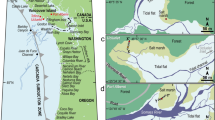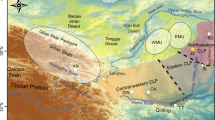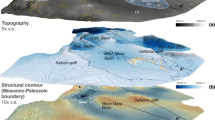Abstract
Extending in a broad arc that abuts the sandy (non-Gobi) deserts, the loess plateau of northern China1–3 is one of the most massive accumulations of loess in the world. The loess sequence is typically characterized by an alternation of silty or sandy loess with more clay-rich palaeosols. These alternations, in conjunction with their enclosed faunas and distinctive mineralogies, have been interpreted as reflecting Pleistocene glacial/interglacial cycles3–8. Because it holds implications for the climatic and anthropological history of China9,10, the definition of a reliable chronological framework for loess deposition is of great interest. Recent palaeomagnetic studies4,5 have indicated that loess deposition in Shaanxi province commenced ∼2.4 Myr ago. To assess the synchrony of loess accumulation across the loess plateau, we have dated a 330-m-thick loess sequence near Lanzhou, Gansu province. The magnetostrati-graphical results reported here indicate that the base of this loess succession dates from ∼1.3 My r ago. This young age (in comparison to the Shaanxi sequence) is attributed to uplift along the northern fringe of the Tibetan Plateau11 that precluded early Pleistocene loess preservation in this mountainous region. Palaeosols in the basal loess occur, on average, once every 25 kyr, suggesting that climates conducive to soil-forming events may have been modulated by orbital precession in the early Pleistocene.
This is a preview of subscription content, access via your institution
Access options
Subscribe to this journal
Receive 51 print issues and online access
$199.00 per year
only $3.90 per issue
Buy this article
- Purchase on Springer Link
- Instant access to full article PDF
Prices may be subject to local taxes which are calculated during checkout
Similar content being viewed by others
References
Liu, T. S. & Chang, T. H. Rep. 6th int. Congr. Quat. Warsaw 6, 503–524.
Liu, T. S., Wang, T. M., Wang, K. L. & Wen, L. C. Sci Rec. 2, 167–174 (1958).
Sasajima, S. & Wang, Y. Y. The Recent Research of Loess in China (Kyoto University and Northwest University, 1984).
Heller, F. & Liu, T. S. Nature 300, 431–433 (1982).
Heller, F. & Liu, T. S. Geophys. J. R. astr. Soc. 77, 125–141 (1984).
Chen, D. N. et al. Proc. 3rd Nat., China (1979).
Liu, T. S., Wen, O. Z., An, Z. S. & Zheng, H. H. Int. geol. Congr., Paris (1980).
Zheng, H. H., in Quaternary Geology and Environment of China (ed. Liu, T. S.) 59–66 (China Ocean Press, Beijing, (1982).
Woo, R. K. Kexue Tongbao 6, 1966).
Wang, Y. Y. & Xue, S. S. in Loess and Quaternary Geology (ed. Wang, Y. Y.) 88–98 (People's Press, Shaanxi Province, Xian, 1982).
Li, J. et al. Scient. Sinica 22, 1314–1328 (1979).
Kukla, G. J. in After the Australopithecines (eds Bytzer, K. W. & Issac, G. L.) 99–188 (Mouton, The Hague, 1975).
Fink, J. & Kukla, G. J. Quat. Res. 7, 363–371 (1977).
Shackleton, N. J. et al. Nature 307, 620–623 (1984).
Wang, Y. Y., in Loess and Quaternary Geology (ed. Wang. Y. Y.) 20–47 (People's Press, Shaanxi, (1982).
Fisher, R. A. Proc. R. Soc. A 217, 295–305 (1953).
Johnson, N. M. et al. Palaeogeogr., Palaeoclimatol., Palaeoecol, 37, 17–42 (1982).
Mankinen, E. A. & Dalrymple, G. B. J. geophys. Res. 84, 615–626 (1979).
Harland, W. B. et al. A Geologic Time Scale (Cambridge University Press, 1982).
Liu, T. S., Gu, X. F., An, Z. S. & Fang, Y. X. in Desert Dust: origin Characteristics and Effect on Man (ed. Pewe, T. L.) 149–158 (Geological Society of America, Boulder, 1981).
Xu, R. in Geological and Ecological Studies of the Qinghai-Xizang Plateau Vol. 1 139–144 (Science Press, Beijing, 1981).
Tapponier, P. & Molnar, P. J. geophys. Res. 82, 2905–2930 (1977).
Molnar, P. & Tapponier, P. J. geophys. Res. 83, 5361–5375 (1978).
Berger, A. in Milankovitch and Climate, Part I (eds Berger, A., Imbrie, J., Hays, J., Kukla, G. & Saltzman, B.) 3–39 (Reidel, Dordrecht, 1984).
Hays, J. D., Imbrie, J. & Shackleton, N. J. Science 214, 1121–1132 (1976).
Author information
Authors and Affiliations
Rights and permissions
About this article
Cite this article
Burbank, D., Jijun, L. Age and palaeoclimatic significance of the loess of Lanzhou, north China. Nature 316, 429–431 (1985). https://doi.org/10.1038/316429a0
Received:
Accepted:
Issue Date:
DOI: https://doi.org/10.1038/316429a0
This article is cited by
-
Diverse manifestations of the mid-Pleistocene climate transition
Nature Communications (2019)
-
Demographic expansion of two Tamarix species along the Yellow River caused by geological events and climate change in the Pleistocene
Scientific Reports (2018)
-
A sedimentary paleomagnetic record of the upper Jaramillo transition from the Lantian Basin in China
Earth, Planets and Space (2015)
-
Soil erosion response to climatic change and human activity during the Quaternary on the Loess Plateau, China
Regional Environmental Change (2006)
-
The new basic theory on Quaternary environmental research
Journal of Geographical Sciences (2004)
Comments
By submitting a comment you agree to abide by our Terms and Community Guidelines. If you find something abusive or that does not comply with our terms or guidelines please flag it as inappropriate.



